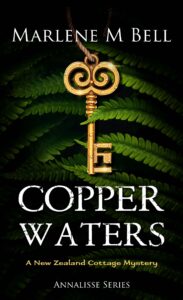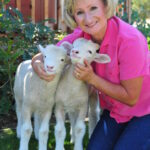 Today’s special guest is cozy mystery author Marlene M. Bell. We’re chatting about the fourth novel in her New Zealand Cottage Mystery series, Copper Waters.
Today’s special guest is cozy mystery author Marlene M. Bell. We’re chatting about the fourth novel in her New Zealand Cottage Mystery series, Copper Waters.
Bio:
Marlene M. Bell is an eclectic mystery writer, artist, photographer, and she raises sheep in beautiful East Texas with her husband, Gregg, three cats and a flock of horned Dorset sheep.
The Annalisse series has received numerous honors including the Independent Press Award for Best Mystery (Spent Identity,) and FAPA— Florida Author’s President’s Gold Award for two other installments, (Stolen Obsession and Scattered Legacy.) Her mysteries with a touch of romance are found at marlenembell.com.
She also offers the first of her children’s picture books, Mia and Nattie: One Great Team! Based on true events from the Bell’s ranch. The simple text and illustrations are a touching tribute of compassion and love between a little girl and her lamb.
Welcome, Marlene. Please tell us about your current release.
Copper Waters is the fourth book in the Annalisse Series, released in paperback and eBook on 12-7-22. It’s the newest installment in the international adventures featuring Annalisse Drury and Alec Zavos, friends who are finding their way to each other through a rocky relationship entwined with murder investigations, personal mayhem, family secrets, and suspenseful, tempting romance. They travel to exotic countries such as: Greece, Turkey, Italy, and in Copper Waters, New Zealand. Will Annalisse and Alec work through their differences in Copper Waters? The series continues…
 What inspired you to write this book?
What inspired you to write this book?
Because I raise sheep with my husband, and have for forty years, I wanted readers to experience what it’s like to take a journey in the company of these animals. What better way to do this than to bring the audience to a gorgeous setting like New Zealand? There are more sheep than people in that island country. It also gives readers a chance to understand a place that few of us will get to visit in our lifetimes. My books are meant as a window to the sights and sounds of other cultures across the oceans. Through research, with each new book installment, I’m also learning along with my readers!
Excerpt from Copper Waters:
(This is description and dialog between Annalisse and Bill Drake, their private investigator friend who travels with her to New Zealand.)
“Today we’re on the way to Woolcombe Station and in livestock country big time. I’ve researched the current sheep population at almost thirty million, at a rate of about five sheep for every person in New Zealand. Sheep and lamb numbers continue to drop due to loss of the land needed to produce meat and wool. Raising vineyards for wine grapes has become popular, and many farmers have turned to dairy farms, not to mention the urban development to house an increase in the country’s overall population. In the past twenty years, New Zealand has gained two million residents. What began as seventy million sheep in 1982 has rapidly been on the decline.
The animal kingdom still dominates this nation. From the moment we hop in our SUV and hit the main route toward Woolcombe Station, the hillsides’ deep crevices spill into miles upon miles of rocky pastures less suitable for humans but more to grazing animals like sheep and crossbred cattle. I don’t recognize any single cattle breed except perhaps black Angus. Cows of mixed colors and shapes, some with horns, most without, support a hearty gene pool of four-legged critters, with ancestors that made ship voyages as far back as the 1800s. In addition to the one hundred thousand indigenous Māori population, first New Zealand settlers were convicts from penal colonies in Australia, or they traveled over three months on the ocean, seeking seals and whales for fur, fat, and lamp oil.
Out my window, red-roofed homesteads nestle at the base of taller peaks, surrounded by large, natural Totara shade trees, owner-operator granaries, woolsheds, and cooking stations. Bunkhouses for workers and shearers are rough and unpainted, broken down from age—a throwback from the war years when the world began to hum back to life in the 1970s after Vietnam. Those wars include Aussies and Kiwis fighting alongside the United States against aggressors pushing communism on a gullible public.
Bill and I drive past a smaller station, paddocks and chutes sporting little white bodies awaiting the shearers. I hope Bill will get to see how shearing is undertaken while we’re visiting, or Ethan can show us another station with shearers at work. I’d like to photograph them in action.
“This is going to sound like a stupid question, but what exactly is a sheep station?” Bill asks. “We have farmers raising sheep in our country, but I’ve never heard anyone call them stations. What am I missing?”
I smile. “Kate says there’s no such thing as a stupid question, and she’s right. A sheep station is their terminology for sheep farms in Australia and New Zealand. We’re going to see how farmers and ranchers make a living in rough, mountainous country. Their livelihoods depend totally on their sheep and cattle management.”
Bill nods.
“With sheep, there’s more labor involved because of the shearing. Most breeds grow fleece that have to be shorn at least once a year. A few breeds in the US no longer grow fleece because the farmer wants to concentrate on a meat market. They’re called hair sheep. Small amounts of wool grow but shed off on their own, leaving hair on the hides. In the US, we don’t wear as much wool clothing as we did in the 1700s and 1800s. Our founders raised sheep because woolens were in demand for warmth and military uniforms. The price for wool was high back then because it was needed in society.”
“If there’s wool in the cloth, I run the other way. It’s too scratchy for me,” Bill says.
“Mills have an answer to that. It’s called worsted wool. It’s stronger, finer, and smoother than regular wool that’s rough and scratchy. Men’s and women’s suits are usually made with worsted wool because it has a softer feel. Your short lesson on wool for today.” I laugh softly. “New Zealand sheep stations take the all-of-the-above approach. Stations employ sheep shearers and rouseabouts, sell the wool, and raise lambs for meat. Much of that is exported around the world.” I change the subject. “Are you okay with going to the police station first? If you think it’s better that we go in together, I can put off the station visit until this afternoon.”
I have a guilty conscience about sending Bill Drake to the wolves once he takes me to the station.
“It’s best that I test the water with the police. See Ethan and meet his family.”
What exciting story are you working on next?
I’m taking a temporary break from the series to write a standalone unrelated to the Annalisse novels. Sticking with my love of writing mysteries and him/her relationships, I’ll have a whole new batch of characters ready and willing to experience troublesome events! The story takes place in a fictitious town located near the panhandle of Texas during a very cold winter. The protagonist is a culinary gourmet or sorts. An out-of-work pastry chef due to her own choosing—where life has taken her closer to immediate family. She’s moved from a celebrity personal chef position in California to be with her father after the passing of her mother. More than one man will vie for my main character’s affections as they solve unexpected havoc taking place in a Civil War vintage home. A home she’s inherited.
When did you first consider yourself a writer?
It happened on a dare, actually! Our 4-H club of sheep students and their parents asked me to write a book on raising sheep, since there are few on the market. I took up the challenge and wrote a memoir with the addition of raising sheep in the back section of the book. Not the best combination for non-fiction, but I liked the experience. I knew little about writing that type of book, or any book for that matter and the effort was marginal at best.
In 2010 I looked into an even bigger challenge; how to write genre fiction. Eight years later, Stolen Obsession, my first installment of the Annalisse series, was published. Once the series took hold in print, I considered myself a bonified author.
Do you write full-time? If so, what’s your work day like? If not, what do you do other than write and how do you find time to write?
I write every day, even if it’s only a few minutes at a time. My day job includes writing fiction and also shipping orders to my clients from our sheep gifts website. I’ve been involved in selling sheep related gifts since 1985, way before I ever thought to write anything more than articles on raising sheep. (Also found on the Ewephoric website.) My photographs and art are a huge part of my day, from taking pictures of our beautiful Texas sunsets to capturing our sheep and lambs in drawings and on art canvases, or woven tapestries. Our products include these items as well as gifts from other vendors. When I’m not writing, you can find me in the storage area plucking out merchandise for orders through our full-color catalog.
What would you say is your interesting writing quirk?
Looking unorganized while writing. My desk and printer is stacked with research text books, manila folders, spiral-bound books filled with notes, giveaway items and lists of things-to-do sticky note sheets as reminders of things left undone. Enough to cover my wooden desk where barely any wood is left visible. It’s clutter that embarrasses me if anyone were to come up behind and take a picture of my organized mess! I know where everything is, thankfully.
As a child, what did you want to be when you grew up?
I wanted to become a famous painter with a name people would recognize. In a sense, I’m living my lifelong dream, just not exactly how I’d pictured it. Being creative isn’t limited to drawing and painting with pen, pencil, and oil paints. To be a good writer depends on how well we paint our pictures in the minds for our readers. Writers are challenged to be expressive artists in well-written prose that entertains—and brings out a vision where the reader feels they are part of the story happening around them each time they open a book.
Anything additional you want to share with the readers?
The Annalisse series is filled with enhanced accounts of my life with sheep. Events that have happened to me along the way, both good and bad. My main character is very familiar… She’s a lover of history and antiques and notorious for jumping straight into projects and investigations, often finding that she’s jumped too soon and made matters worse for her and Alec. Me, in a nutshell.
I hope you’ll add the Annalisse series books to your To-Be-Read mystery stack and will check out the newest installment, Copper Waters! Thank you for the opportunity to visit with you.
Links:
Website | Ewephoric gift website | Facebook Author page | Twitter | BookBub | Goodreads | Instagram | Amazon | Barnes and Noble
Thanks for being here today, Marlene.

Lisa,
Thank you for featuring my new release mystery, Copper Waters. It’s a pleasure to be with your audience today! I hope everyone will take a look at the Annalisse Series and the books for the To-Be-Read file. Have a pleasant, safe and warm holiday with family and friends. On to 2023~~